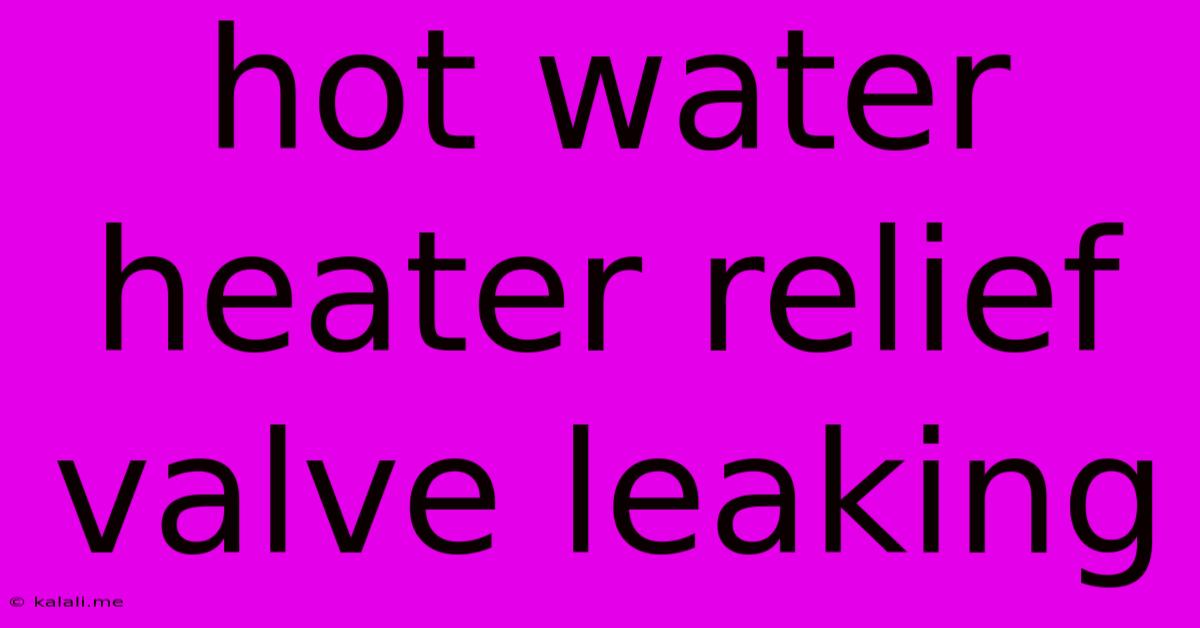Hot Water Heater Relief Valve Leaking
Kalali
May 25, 2025 · 3 min read

Table of Contents
Hot Water Heater Relief Valve Leaking: Causes, Fixes, and Prevention
A leaking hot water heater relief valve is a serious issue that demands immediate attention. Ignoring a leak can lead to significant water damage, property damage, and even injury. This article will delve into the common causes of a leaking relief valve, explain how to troubleshoot the problem, and offer preventative measures to keep your water heater running smoothly.
Why is my hot water heater relief valve leaking? This is a common question among homeowners. A dripping or spraying relief valve indicates a problem within the water heater's pressure regulation system. Several factors contribute to this issue:
Common Causes of a Leaking Hot Water Heater Relief Valve
-
Excess Pressure: The most frequent culprit is excessive pressure within the tank. This can stem from a faulty pressure regulator valve, a malfunctioning temperature and pressure relief (T&P) valve itself, or even sediment buildup within the tank restricting water flow. Overheating due to a faulty thermostat or heating element can also increase pressure.
-
Temperature and Pressure Relief (T&P) Valve Failure: The valve itself may simply be worn out or damaged. Minerals and sediment buildup can impede its proper function, leading to leaks. Constant cycling of the valve due to pressure fluctuations can also cause premature wear.
-
Expansion Tank Issues (If Applicable): If your system utilizes an expansion tank, a malfunctioning or undersized tank might not adequately absorb pressure fluctuations, resulting in pressure build-up and valve leakage.
-
Water Hammer: Sudden changes in water pressure, known as water hammer, can also put stress on the valve and cause it to leak. This is often associated with water pipes and their installation.
Troubleshooting a Leaking Hot Water Heater Relief Valve
Before attempting any repairs, remember safety first! Turn off the power to the water heater (electrical) or the gas supply (gas). Allow the water heater to cool completely.
-
Check for Excess Pressure: Inspect the pressure gauge on the water heater (if equipped). If the pressure is significantly higher than the recommended range (typically 30-50 PSI), this points to excess pressure as the likely cause.
-
Inspect the Relief Valve: Look for any visible damage to the valve itself, such as cracks or corrosion. A simple visual inspection can sometimes identify obvious problems.
-
Test the Relief Valve: Carefully lift the lever on the T&P valve. A small amount of water may escape—this is normal. However, if a significant amount of water continues to flow even after releasing the lever, the valve is likely faulty and needs replacement.
-
Check for Sediment Buildup: If the problem appears to be linked to pressure buildup, consider the possibility of sediment accumulation inside the tank. This may require professional cleaning or tank replacement.
Replacing the Hot Water Heater Relief Valve: A DIY Guide (With Caution)
Replacing the relief valve is a relatively straightforward DIY project for those comfortable working with plumbing. However, if you are unsure, it's always best to call a qualified plumber.
Tools You Might Need:
- Adjustable wrench
- Pipe wrench (potentially)
- New T&P valve (matching the specifications of your existing valve)
- Bucket or container to catch water
Remember: Always turn off the water supply to the heater before commencing any repairs. After replacing the valve, test it to ensure it functions correctly.
Preventing Future Leaks
-
Regular Maintenance: Schedule annual inspections and maintenance for your water heater. This includes checking the pressure relief valve for proper operation.
-
Address Pressure Issues: If you consistently experience high pressure, identify and fix the root cause. A professional plumber can help diagnose and resolve persistent pressure problems.
-
Install a Water Softener: Hard water contributes to sediment buildup. A water softener can help prolong the life of your water heater components, including the relief valve.
-
Monitor Your Water Heater: Regularly check for any leaks or unusual noises emanating from your water heater.
A leaking hot water heater relief valve should not be ignored. While some repairs are DIY-friendly, complex issues necessitate professional assistance. Addressing this problem promptly safeguards your property and ensures the longevity of your water heating system.
Latest Posts
Latest Posts
-
How To Say At All In Spanish
May 25, 2025
-
Blue Black Or White Gold Dress
May 25, 2025
-
How To Fill In A Screw Hole
May 25, 2025
-
How To Clean Burnt Milk Off Stove
May 25, 2025
-
Why Are My Pomegranate Seeds White
May 25, 2025
Related Post
Thank you for visiting our website which covers about Hot Water Heater Relief Valve Leaking . We hope the information provided has been useful to you. Feel free to contact us if you have any questions or need further assistance. See you next time and don't miss to bookmark.